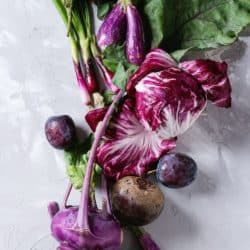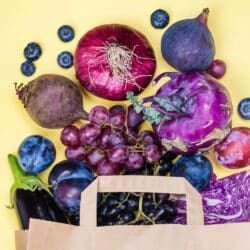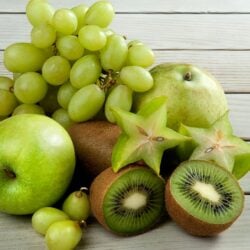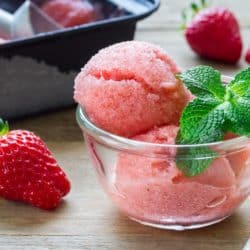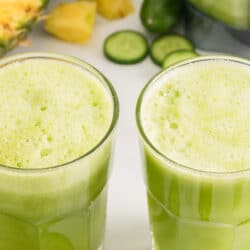15+ Purple Vegetables List (Plus Recipes)
Purple vegetables are a great food to add to your shopping list! They are packed full of powerful antioxidants, plus they taste great. This article includes my purple vegetables list that you can add to your diet with information on how to prepare and eat them.
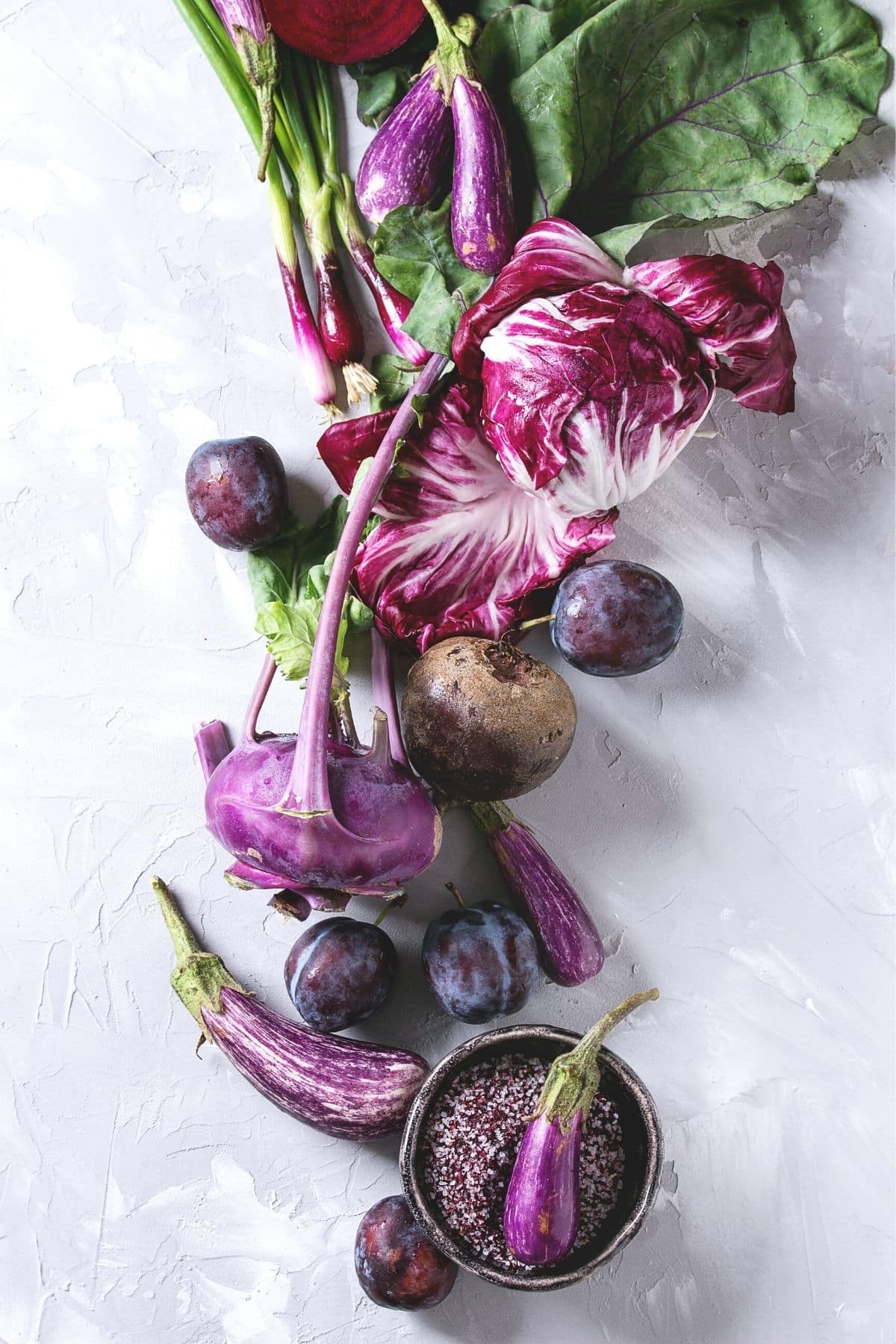
Eating the rainbow is more fun with purple veggies.
Purple vegetables are a great source of antioxidants – specifically anthocyanins, the antioxidant found in plant compounds that contributes to their violet hue.
Purple veggies add color to your diet and help vary your nutrient intake due to their purple pigments.
Purple Vegetables List
Scroll or click on each of these purple vegetables for expanded information on nutrient information and tips on how to prepare these vegetables.
1. Eggplant
Also called aubergine, purple eggplant is slightly bitter with a spongy texture.
- Use it as a side dish or in Mediterranean dishes. It’s best to “sweat” your eggplant by salting it before cooking. It should be cooked before consuming.
- Eggplant is in season from July to October, though you can find it year-round.
2. Purple Potato
Purple potatoes are a nuttier, earthier neighbor to white potatoes.
- Use in place of white potatoes as a side dish. Roasting with olive oil, salt, and pepper is a great way to prepare this veggie. You can also make Instant Pot Boiled Potatoes.
- Purple sweet potatoes are in season year-round but especially the fall.
3. Purple Cabbage
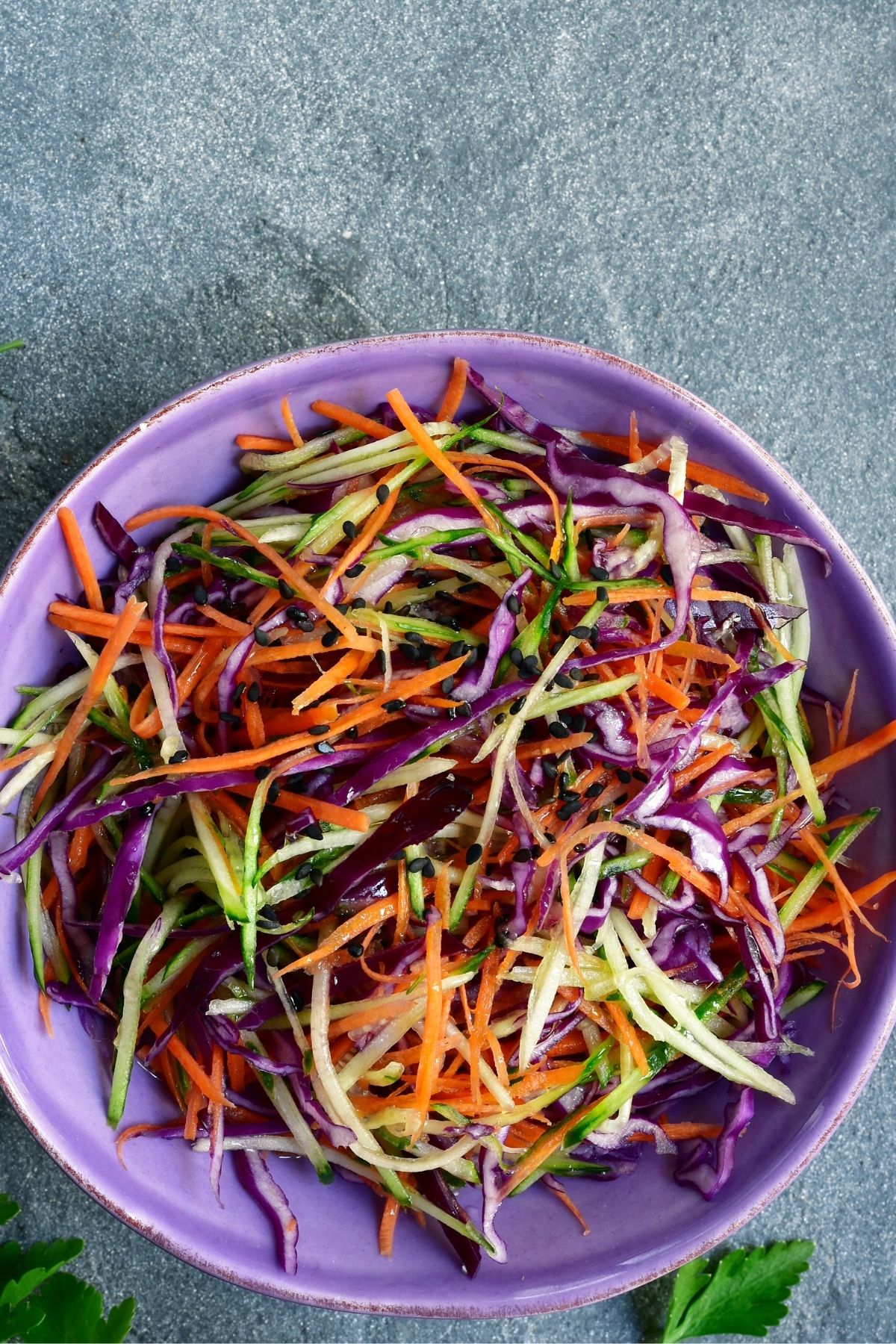
Purple cabbage is a mild-tasting member of the cruciferous vegetable family.
- Purple cabbage is excellent sautéed in dishes like stir fries or eaten raw in slaws or salads. Try this micro-chopped salad recipe or my Air Fryer Cabbage recipe.
- Purple cabbage is in season from October to December (it’s also known as red cabbage).
- This dark purple veggie is a great source of Vitamin C, anthocyanins, and Vitamin K. I like to drink cabbage juice to get a lot of the nutrient benefits!
4. Purple Cauliflower
Purple cauliflower adds a pop of color and slight sweetness to any dish.
- Vibrant purple cauliflower is a cruciferous veggie is delicious roasted with olive oil and sea salt as a side dish. Try my recipe for Instant Pot Cauliflower.
- Purple cauliflower is in season in the fall, though in some areas it’s available year-round.
5. Purple Asparagus
Purple asparagus is a slightly sweeter version of your average asparagus, with a dose of antioxidants and anti-inflammatory properties.
- Purple asparagus turns green when cooked, so eat it raw if you want purple on your plate. It’s great shaved in salads.
- Try making this very simple Instant Pot Asparagus recipe as a side dish.
6. Purple Carrots
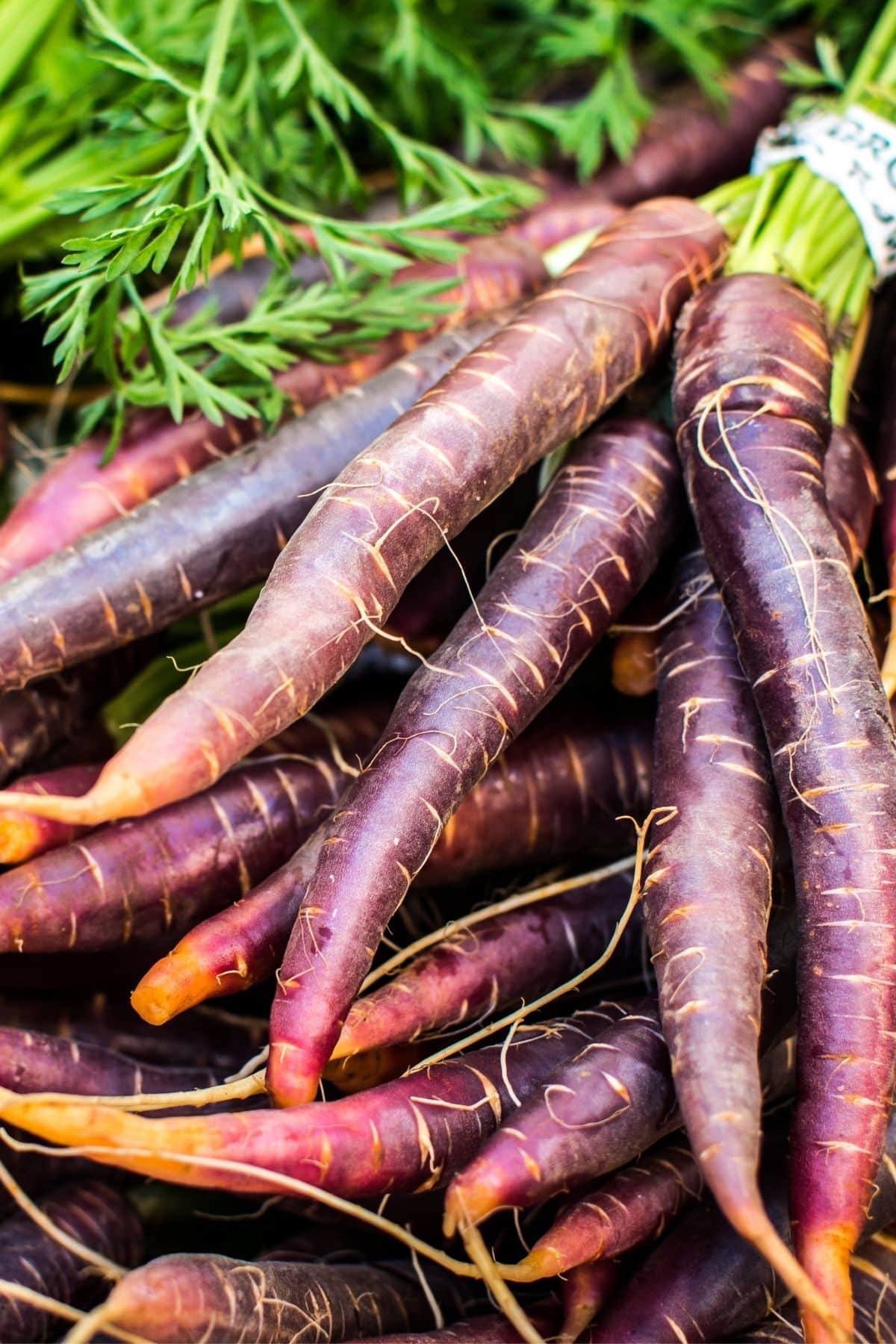
Purple carrots are generally easy to find. They are lower in sugar than orange carrots, with an earthier flavor.
- Roast up some purple carrots alongside orange and white carrots as part of a seasonal side dish. They can be eaten raw to maintain even more nutrients (try my Raw Carrot Salad recipe).
- My Instant Pot Carrots recipe is one of the easiest recipes you’ll find!
- Purple varieties of carrots are in season in the spring and fall.
7. Purple Corn
The special type of purple corn has all the sweetness as its yellow counterpart with a ton of antioxidants. While some people consider corn to be a grain, it also has some vegetable-like properties.
- Purple corn is traditionally consumed as chicha morada, a Peruvian drink made of an entire ear of corn. It’s rarely consumed other than as an additive to desserts.
- Purple corn can only be found in Peru, but purple corn powder is available year-round in specialty grocery stores for use in smoothies or desserts. It would also be great in my Milk-Free Corn Casserole recipe.
8. Purple Pepper
Like other types of peppers, purple peppers get their deep purple color from being harvested at a specific time.
- Purple peppers are great used like other peppers, in everything from stir fries, salads, and Latin dishes.
- Grow your own purple peppers in your vegetable garden from July through December, and be sure to harvest them within 65-70 days of planting. Learn how to freeze peppers to preserve them.
9. Purple Kohlrabi
Purple kohlrabi is a root vegetable with a slight sweetness.
- The purple kohlrabi bulb is best eaten raw in a salad or lightly steamed. The greens can also be consumed in any way you prefer.
- This veggie is in season from fall to spring.
10. Purple Artichokes
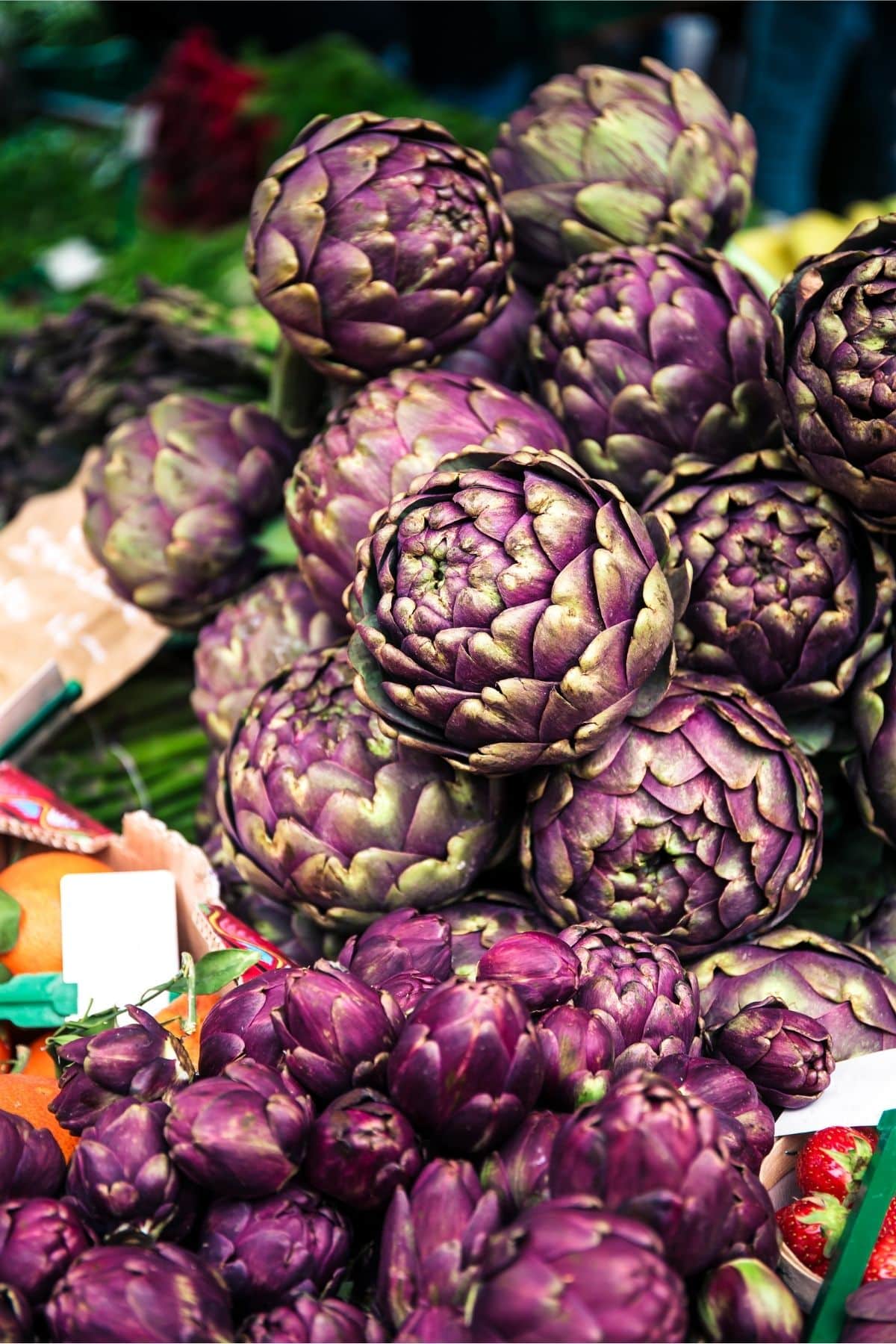
Purple artichokes are similar to green artichokes, with a slightly nuttier flavor.
- Purple artichokes can be prepared in many ways! Roasting or braising in white wine brings out their natural sweetness.
- I also love how easy it is to make Instant Pot Artichokes.
- March through May is the perfect time to find artichokes.
11. Purple Okra
Purple okra is a variety of okra that tastes the same, but is said to have slightly less mucilage, which may make it more palatable for some.
- Use it in a gumbo, pickle it, or roast it lightly with onion powder and salt.
- Okra can be found summer through early fall.
12. Purple Basil
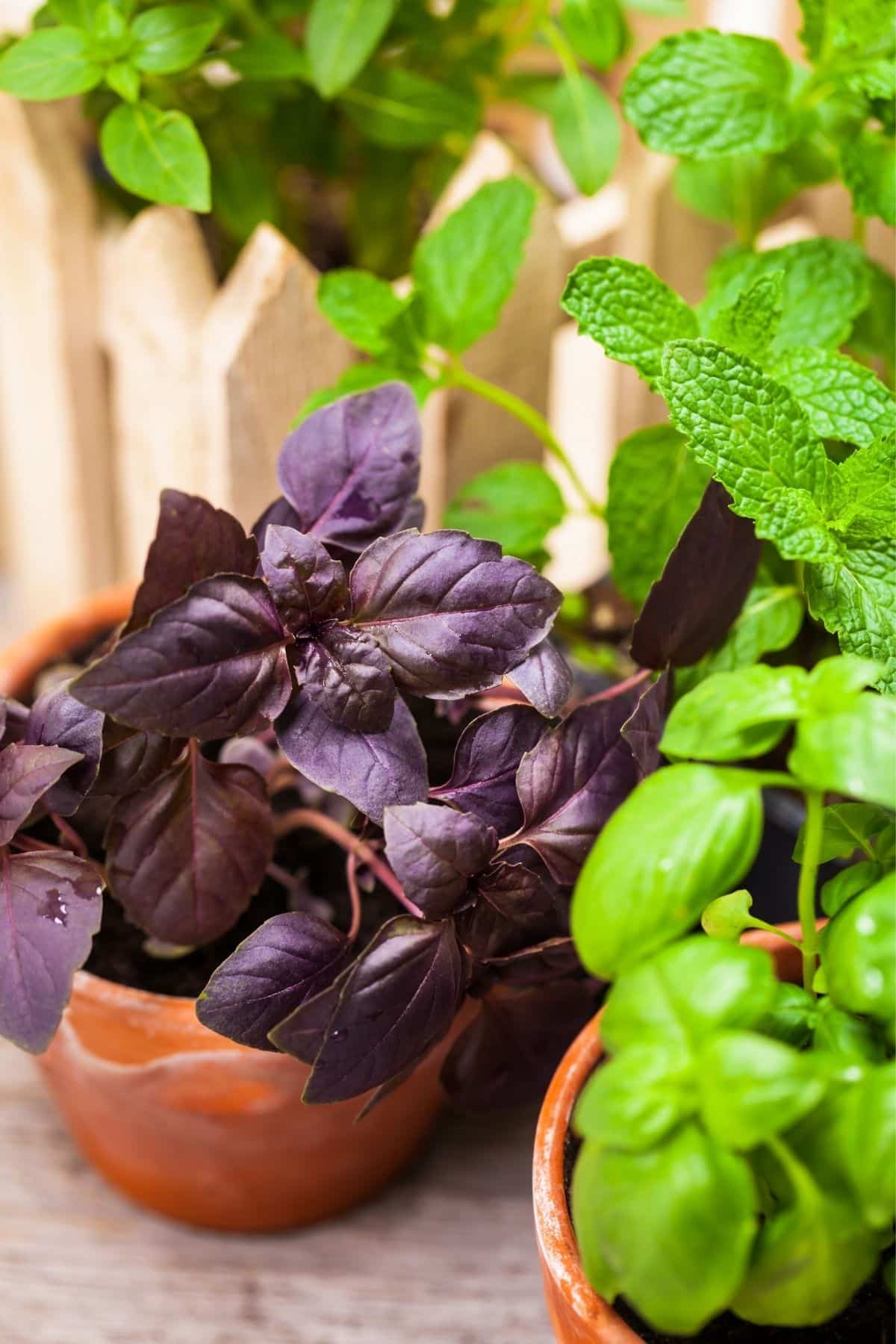
Purple basil has a slightly spiciness to it, contrary to its green counterpart.
- Purple basil is best raw in salads or atop dishes like pizza or pasta. Try it to make my Pesto recipe without cheese.
- This basil grows best in warm weather.
13. Purple Kale
Purple kale has ruffled leaves and a slight cabbage flavor.
It’s a member of the cruciferous veggie family and is an excellent choice to get more “greens” in Cruciferous vegetables are a nutritional powerhouse and also help reduce the risk of cancer..
- Purple kale can be consumed raw or cooked a variety of ways. Try it in a salad, or sautéed as a side dish. You can even lightly bake with spices and nutritional yeast until crispy for a light snack. Try my Air Fryer Kale Chip recipe.
- Purple kale can be found year-round, but especially in winter.
14. Purple Radish
Purple radish is a root vegetable that ranges in flavor from mild to spicy, depending on when it is grown and harvested.
- Purple radish can be consumed raw in salads and sandwiches, or added to dishes like soups or curries. Roasting will temper some of the spicy flavor. I love making Radish Juice!
- Purple radish is available year-round, but especially in the winter and spring.
15. Purple Yam
Also called ube, purple yam is a dense, sweet root vegetable.
- Purple yam is very versatile. Its sweetness lends well to roasting, baking (top with almond butter for a treat!), or even added to desserts (ube ice cream is popular in the Phillippines).
- Purple yam can be found year-round and is considered a purple root veggie.
16. Purple Broccoli
Also known as violet broccoli, purple broccoli has a slightly sweet, nutty flavor with a tender yet crisp texture.
- Use it in stir-fries, salads, or as a colorful side dish. Purple broccoli can be steamed, roasted, or sautéed, but it’s best when briefly blanched to preserve its vibrant color and nutrients.
- Purple broccoli is in season from February to April, though it’s sometimes available year-round.
10 Purple Fruits List
In addition to the purple vegetables listed above, here are 10 bonus fruits that have a natural purple colour.
- Purple grapes
- Plums
- Passion fruit
- Figs
- Blackberries (most have a purple tinge)
- Pomegranates
- Black currants
- Purple dragon fruit
- Acai (try my acai smoothie)
- Elderberry
Purple Vegetable FAQs
The vibrant purple color of these vegetables comes from pigments called anthocyanins.
Purple vegetables often have higher levels of antioxidants due to the presence of anthocyanins. While they share many nutrients and some similar nutritional value with their non-purple counterparts, the added antioxidant properties can make them a more nutritious choice.
To maintain the vibrant color of purple vegetables, it’s best to steam, roast, or sauté them. Boiling can cause them to lose their color and some of their nutrients. Adding a splash of vinegar or lemon juice can help preserve the color during cooking.
You can add purple vegetables to salads, stir-fries, soups, and smoothies. For example, use purple cabbage in slaws, roast purple potatoes, or blend beets into a smoothie. Experiment with different recipes to enjoy the variety of flavors and health benefits.
Absolutely! Purple vegetables are a great way to introduce kids to a variety of flavors and textures. The vibrant color can also make meals more visually appealing, which may encourage picky eaters to try new foods. You can also try growing your own purple veggies in your home vegetable gardens to get kiddos interested.
While some purple vegetables like cabbage and carrots are available year-round, others, such as purple potatoes and certain varieties of eggplant, may be more seasonal. Checking your local farmer’s market can be a great way to find what’s in season.
More Fruit and Veggie Lists You Might Like
- Best Asian Fruits
- Best Green Vegetables
- Best Red Fruits
- Best Vegetables for Picky Eaters
- Fruit That Starts with Z
- Vegetables That Start with M
Don’t Miss These Healthy Food Lists!
Conclusions
Purple vegetables and purple fruits are a worthy addition to your diet. They’re rich sources of antioxidants, especially anti-inflammatory anthocyanins. Try adding at least one of these purple produce items to your shopping cart the next time you’re at the grocery store.
Don’t forget to join my newsletter list to get exclusive clean eating recipes and tips. The newsletter is 100% free with no spam; unsubscribe anytime.
About the Author: Carrie Forrest has a master’s degree in public health with a specialty in nutrition and is a certified holistic nutritionist. She is a top wellness and food blogger with over 5 million annual visitors to her site. Carrie has an incredible story of recovery from chronic illness and is passionate about helping other women transform their health. Send her a message through her contact form.
Note: this post is for informational purposes only and is not intended as medical advice. Please consult your healthcare provider for recommendations related to your individual situation.


